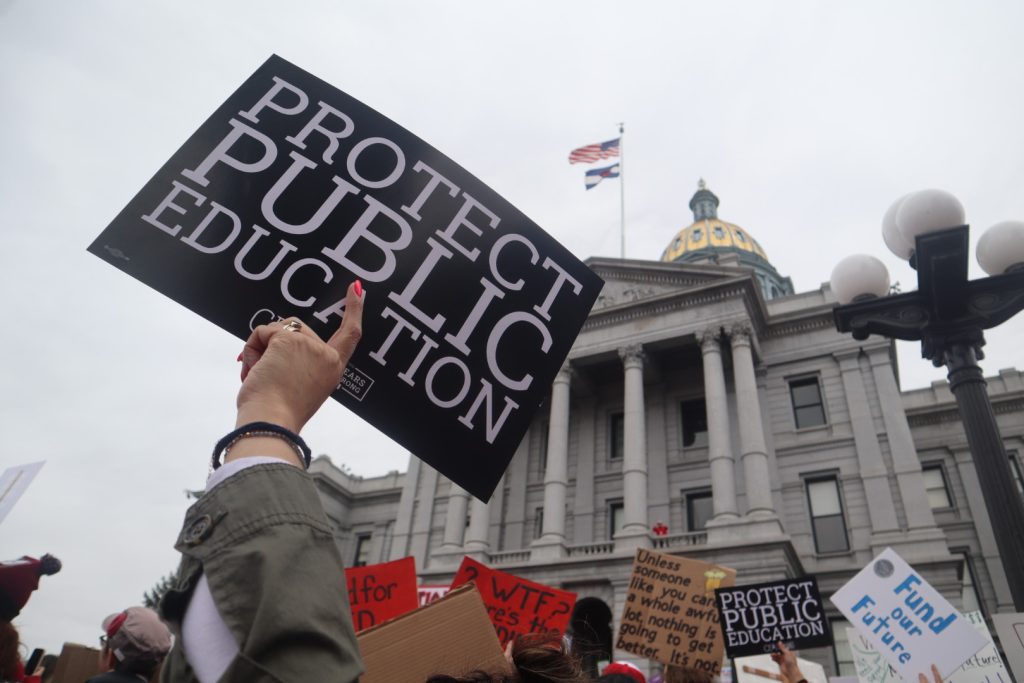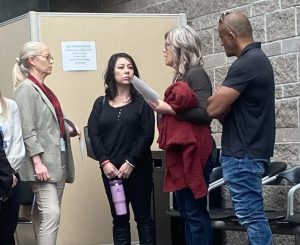Colorado Gov. Jared Polis signs state budget with $1.2B in cuts. Here’s what it means for transit, health care and schools.
Lawmakers were ultimately able to avoid steep cuts to Medicaid and K-12 education by reducing spending on transit infrastructure and social programs

Robert Tann/Summit Daily News
Colorado Gov. Jared Polis on Monday signed into law a $43.9 billion spending plan that caps months of deliberation by lawmakers over how to close a major budget shortfall.
The sprawling package includes $1.2 billion in cuts and shifts in fund accounts in order to balance the state’s 2025-26 budget, which lawmakers said had largely been stressed by higher-than-anticipated Medicaid costs.
To stave off deep cuts to health care and public education, the state’s Joint Budget Committee — a bipartisan six-member group of lawmakers — opted to significantly reduce transportation funding. They also slashed funds for local governments and a slew of social programs, including support for food banks.
“When you have to cut $1.2 billion, you end up with a budget that no one really likes but that we can all be proud of,” said joint budget committee chair Sen. Jeff Bridges, D-Greenwood Village, during a bill signing ceremony at the governor’s mansion, “because we made those cuts in a way that protected public education, protected public safety, protected public health.”
Lawmakers warned, however, that budgets will be even tighter in future years.

Support Local Journalism
Along with rising health care costs, Colorado has seen an influx of federal COVID-19 relief money dry up. The state also continues to be limited in how much tax revenue it can take in and spend due to the Taxpayer’s Bill of Rights, or TABOR.
“Make no mistakes, our job ahead is still pretty daunting,” said Sen. Barbara Kirkmeyer, R-Brighton. “You don’t get out of a structural deficit in a one-year cycle. This is a two-, three-, four-year cycle and we have to work hard and make sure we are doing our due diligence to make sure that we are making the cuts.”
Here’s what is — and isn’t — in the 2025-26 budget:
Transportation

Transportation absorbed some of the biggest cuts.
Lawmakers cut $64 million from the State Highway Fund in the 2025-26 fiscal year and another $50 million the following fiscal year, money that would eventually be repaid by 2033.
The cuts will mainly impact the Colorado Department of Transportation’s 10-year plan for capital projects, which represents hundreds of planned and ongoing infrastructure initiatives throughout the state.
The decision raised alarms from transportation advocates who said it could delay already languishing projects, particularly in mountain communities where adverse weather and traffic congestion pose significant threats to rural infrastructure.
Colorado ranks as one of the worst states in the nation for road conditions. A recent report by the Reason Foundation, a nonprofit think tank, found the state ranked 47th for rural highway pavement and 45th for urban highway pavement.
Along with cuts to the State Highway Fund, lawmakers clawed back $71 million in unspent grant money for multimodal transit projects, such as bike lanes and pedestrian safety improvements. They also eliminated $7 million for a Revitalizing Main Streets grant program, which supports downtown sidewalk expansions, enhanced public spaces and bus stop improvements.
While the program represents a sliver of the state’s overall public infrastructure spending, transit advocates said it has an outsized effect on rural communities.
“When you’re talking about a small community, an award of under $200,000 is still really valuable and important to that community,” said Ann Rajewski, executive director for the Colorado Association of Transit Agencies, in an April 4 interview. “We can’t forget that these rural agencies and the rural towns in our state … it really adds value to the community’s life.”
The budget also reduces vehicle registration fees by $3.70 per vehicle over the next two years. For the average car, which weighs between 2,001 and 5,000 pounds, that represents a decrease from $23 to $19.30.
The fee reduction was done to free up more money in the general fund, which is the state’s discretionary spending account, from the spending cap under TABOR.
Health care

The state this year saw a dramatic increase in Medicaid costs driven by more patients using long-term care. Medicaid and K-12 education are the two biggest spending areas for the state’s general fund.
With the government-subsidized health care program facing an uncertain future at the federal level, lawmakers sought to minimize state cuts to Medicaid.
The 2025-26 budget includes a 1.6% increase to the state’s Medicaid reimbursement rate. Because the rate increase is below the rate of inflation, however, it will effectively serve as a cut for health care providers.
A group of lawmakers, many of whom are from the Western Slope, sought to bolster state funding for federally qualified health centers, which serve as safety net clinics for uninsured and underinsured patients, especially in rural areas.
But an amendment to increase general fund spending for the health centers by $5.6 million — money that could have been equally matched by federal funds — was stripped from the final version of the budget.
Bridges said another bill working its way through the Legislature would have a far more significant impact on federally qualified health centers compared to the budget amendment that was brought forward.
That measure, Senate Bill 290, would provide $25 million in funding for the 2025-26 fiscal year for safety net providers serving low-income, uninsured individuals, with tens of millions more in subsequent years. The funds would come from the Treasury Department’s unclaimed property trust fund.
Bridges called the bill a “short-term solution” to ensuring community clinics have adequate funding.
“These folks work on the front lines of health care serving the most vulnerable Coloradans,” Bridges said. “Ensuring that they have the ongoing, long-term strong support that they need from the state is critical. … (SB) 290 buys us some time to figure it out.”
Bridges believes the bill has the support to make it to the governor’s desk. It passed the Senate on Monday in a 33-1 vote. Another measure, House Bill 1174, also seeks to aid federally qualified health centers by capping state reimbursements for large hospitals and redirecting that money to community clinics.
Bridges is a sponsor of both bills.
Education

Both lawmakers and the governor had pledged to protect the progress made to better fund the state’s public schools.
Last year, lawmakers changed the school finance formula to provide additional funding for at-risk special education students, English language learners and rural districts, providing $500 million in new spending over the next six years.
They also eliminated the budget stabilization factor, a Great Recession-era mechanism that had underfunded schools by around $10 billion over the past 14 years.
The 2025-26 budget increases general fund spending for K-12 education by $150 million to begin implementing the new finance formula. While the state budget allocates the money, a separate bill called the School Finance Act will dictate how the funds are spent.
That bill is being led by Colorado House Speaker Julie McCluskie, D-Dillon, and represents a compromise to an earlier proposal put forward by Polis that would have overhauled how schools receive funding based on enrollment.
Districts currently have the option to use a four-year enrollment average to determine their student funding count. Polis’ plan would have done away with that, instead funding schools based on a current-year student count starting next school year.
Educators warned the move could cause whiplash for smaller districts with declining enrollments, potentially jeopardizing tens of millions of dollars in funding even as overall state spending is poised to increase.
McCluskie’s proposal, which passed the House and is moving through the Senate, would keep the four-year averaging in place but phase it out over the next several years, ensuring schools have time to adjust. It would, however, extend by another year the timeline for when the additional $500 million designated for schools is set to be allocated.
While Polis’ proposal called for allocating 18% of the $500 million next school year, McCluskie’s plan would issue 15%. Still, because of the difference in averaging, McCluskie claims her plan would net school districts more funding overall.
Both scenarios would increase school funding, but not to the extent originally promised under the reforms made last year. Lawmakers will also have to continue to boost funding and stave off cuts for public education, even as they forecast tighter budget years, if they are to fully implement the new formula.










